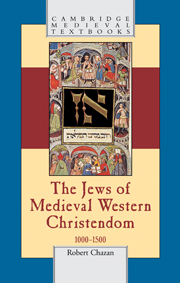Book contents
- Frontmatter
- Contents
- List of maps
- Preface
- Introduction
- 1 Prior legacies
- 2 The pan-European Roman Catholic Church
- 3 The older Jewries of the south
- 4 The newer Jewries of the north: northern France and England
- 5 The newer Jewries of the north: Germany and Eastern Europe
- 6 Material challenges, successes, and failures
- 7 Spiritual challenges, successes, and failures
- Epilogue
- Notes
- Bibliography
- Index
- Cambridge Medieval Textbooks
Introduction
Published online by Cambridge University Press: 05 June 2012
- Frontmatter
- Contents
- List of maps
- Preface
- Introduction
- 1 Prior legacies
- 2 The pan-European Roman Catholic Church
- 3 The older Jewries of the south
- 4 The newer Jewries of the north: northern France and England
- 5 The newer Jewries of the north: Germany and Eastern Europe
- 6 Material challenges, successes, and failures
- 7 Spiritual challenges, successes, and failures
- Epilogue
- Notes
- Bibliography
- Index
- Cambridge Medieval Textbooks
Summary
An observer viewing world Jewry in the year 1000 would have readily discerned an obvious Jewish demographic distribution and an equally obvious configuration of Jewish creativity. The oldest, largest, and most creative Jewish communities were located in the Muslim sphere, stretching from Mesopotamia westward through the eastern littoral of the Mediterranean Sea, across North Africa, and over onto the Iberian peninsula. Somewhat smaller, but still sizeable and venerable were the Jewish communities of the Byzantine Empire. Our putative observer might have noted, as an afterthought, the small Jewish settlements in western Christendom, huddled along the northern shores of the Mediterranean Sea, in Italy, southern France, and northern Spain; he might have – reasonably enough – not even bothered to mention them, for they would hardly have seemed worthy of serious attention.
Our observer would almost certainly have known that this pattern of Jewish demography and creativity had been established more than a thousand years earlier, long before the rise of Islam to its position of power during the seventh century. He would have been aware that, subsequent to the exile of the Jews from their homeland in the sixth pre-Christian century, two major centers of Jewish life had emerged, one as the result of Jewish resettlement in Palestine and the other as a result of the decision of Jews to secure for themselves a permanent place in Mesopotamia.
- Type
- Chapter
- Information
- The Jews of Medieval Western Christendom1000–1500, pp. 1 - 22Publisher: Cambridge University PressPrint publication year: 2006

